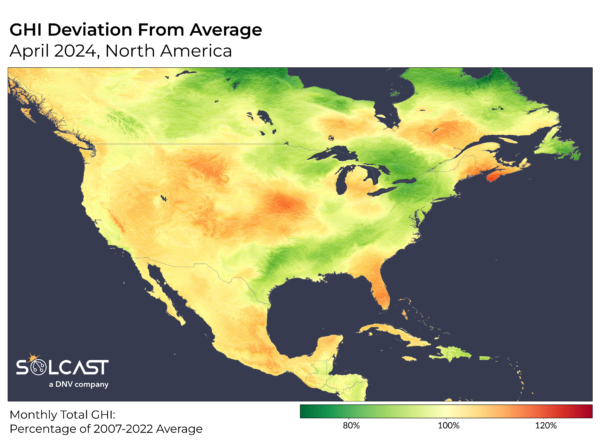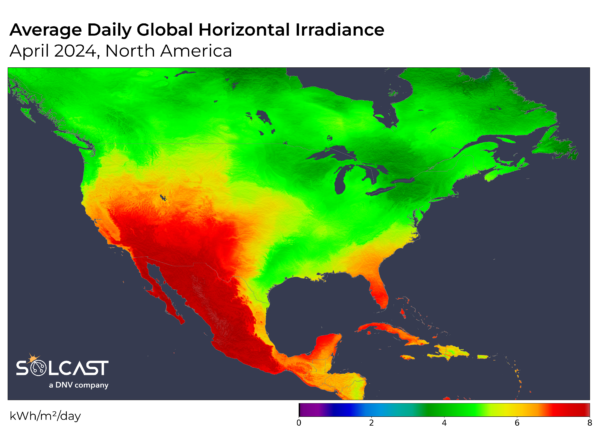April 2024's irradiance patterns over North America were shifted by a Pacific high-pressure anomaly and drier air over the tropics, delivering favorable irradiance results for large solar regions in the Southwest. Solar assets in Texas slightly underperformed compared to the long term average, as low pressure systems and an end-of-month tornado outbreak impacted irradiance.

Florida and parts of Mexico witnessed above-average solar irradiance in April, benefiting from unusually dry tropical air masses. Florida's solar irradiance rose to 10% above the April average, with Mexico also enjoying a 5% increase. These areas are usually the brightest spots in North America during April, with a long term April average of up to 7.7 kWh/day in Mexico and 6.6 kWh/day in Florida.
The surge in solar potential was linked to a broad swath of below-average relative humidity across the tropics, which substantially reduced cloud cover and boosted photovoltaic production.
A significant high-pressure anomaly in the Pacific fostered more settled conditions and pushed a deep layer of dryer air over the Western United States, resulting in clearer skies. Whilst coastal regions saw average to slightly more irradiance than normal, Midwestern states including Iowa, Nebraska, Kansas, and Wyoming, received up to 110% normal levels.

Popular content
Contrastingly, Texas, the northeastern United States, and parts of Canada faced below-average solar irradiance, primarily due to persistent low-pressure systems and storms. Texas saw irradiance figures around 5% below the norm, while New York state and adjacent Canadian areas recorded a 10% decrease.
The adverse conditions, including above-average rainfall and cloud cover from the severe thunderstorms, hampered PV generation significantly. Additionally, a severe weather outbreak in Texas from April 26 to 29 brought tornadoes and large hail, posing risks not only to irradiance but also to the physical integrity of PV installations and power transmission infrastructure.
Solcast produces these figures by tracking clouds and aerosols at 1-2km resolution globally, using satellite data and proprietary AI/ML algorithms. This data is used to drive irradiance models, enabling Solcast to calculate irradiance at high resolution, with typical bias of less than 2%, and also cloud-tracking forecasts. This data is used by more than 300 companies managing over 150GW of solar assets globally.
The views and opinions expressed in this article are the author’s own, and do not necessarily reflect those held by pv magazine.
This content is protected by copyright and may not be reused. If you want to cooperate with us and would like to reuse some of our content, please contact: editors@pv-magazine.com.


By submitting this form you agree to pv magazine using your data for the purposes of publishing your comment.
Your personal data will only be disclosed or otherwise transmitted to third parties for the purposes of spam filtering or if this is necessary for technical maintenance of the website. Any other transfer to third parties will not take place unless this is justified on the basis of applicable data protection regulations or if pv magazine is legally obliged to do so.
You may revoke this consent at any time with effect for the future, in which case your personal data will be deleted immediately. Otherwise, your data will be deleted if pv magazine has processed your request or the purpose of data storage is fulfilled.
Further information on data privacy can be found in our Data Protection Policy.